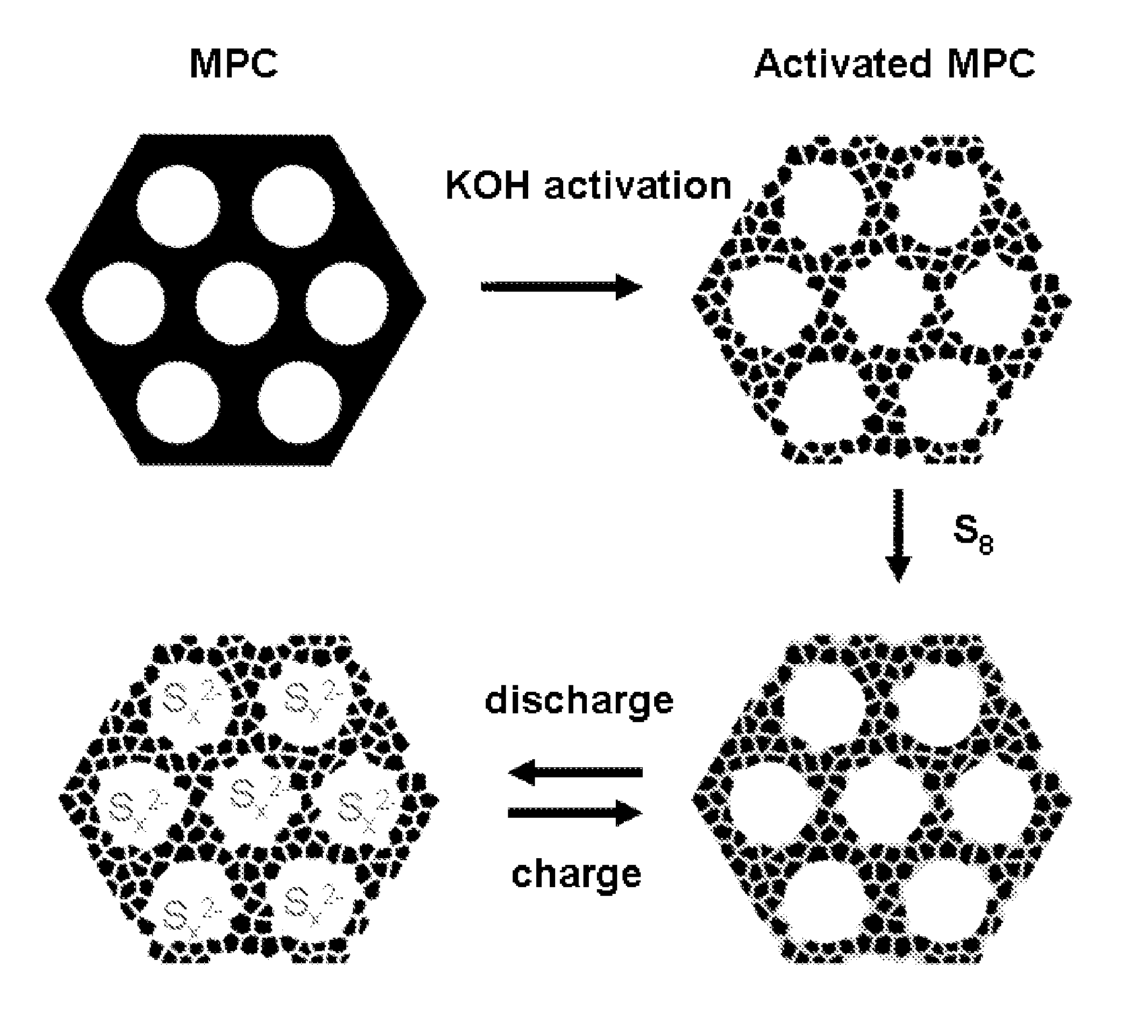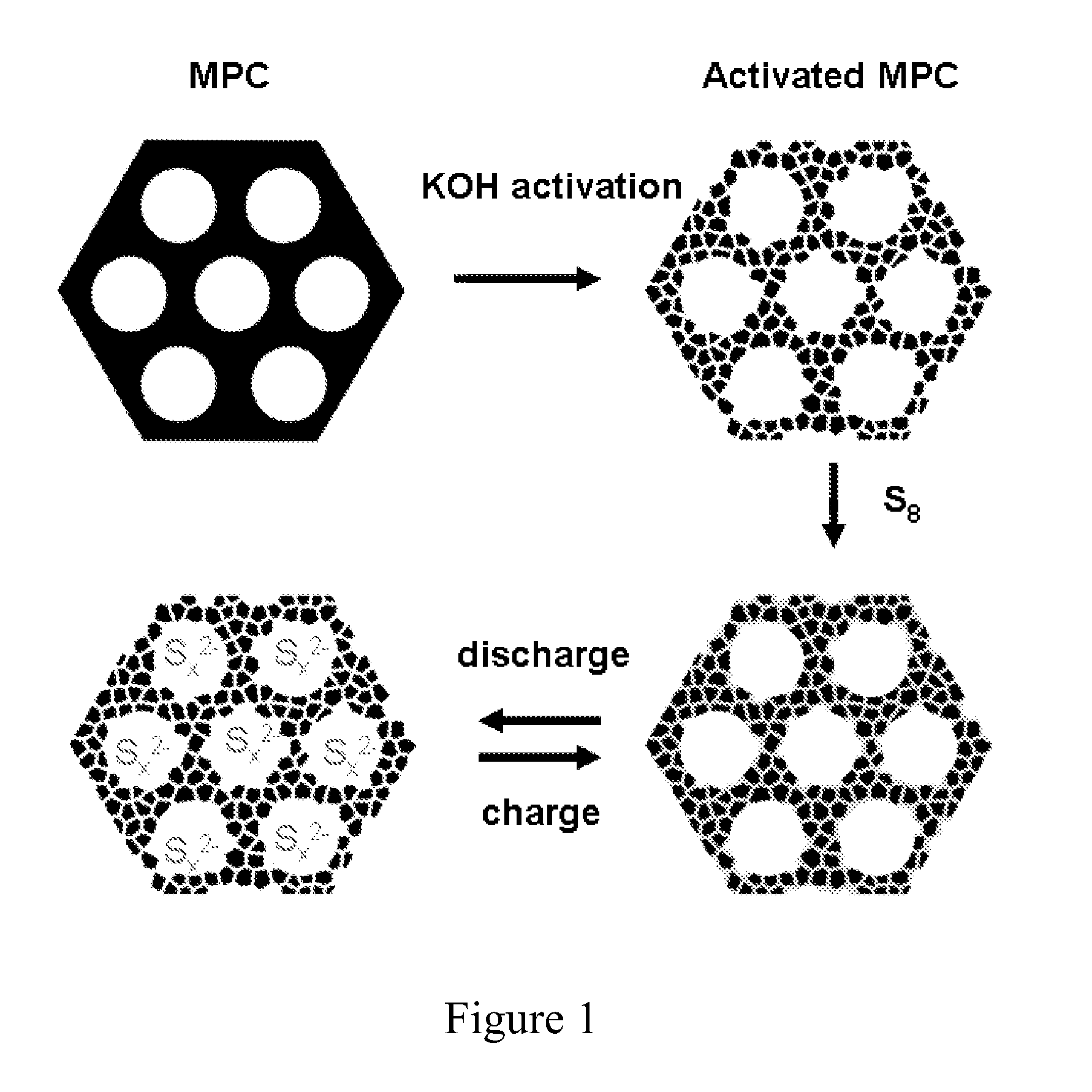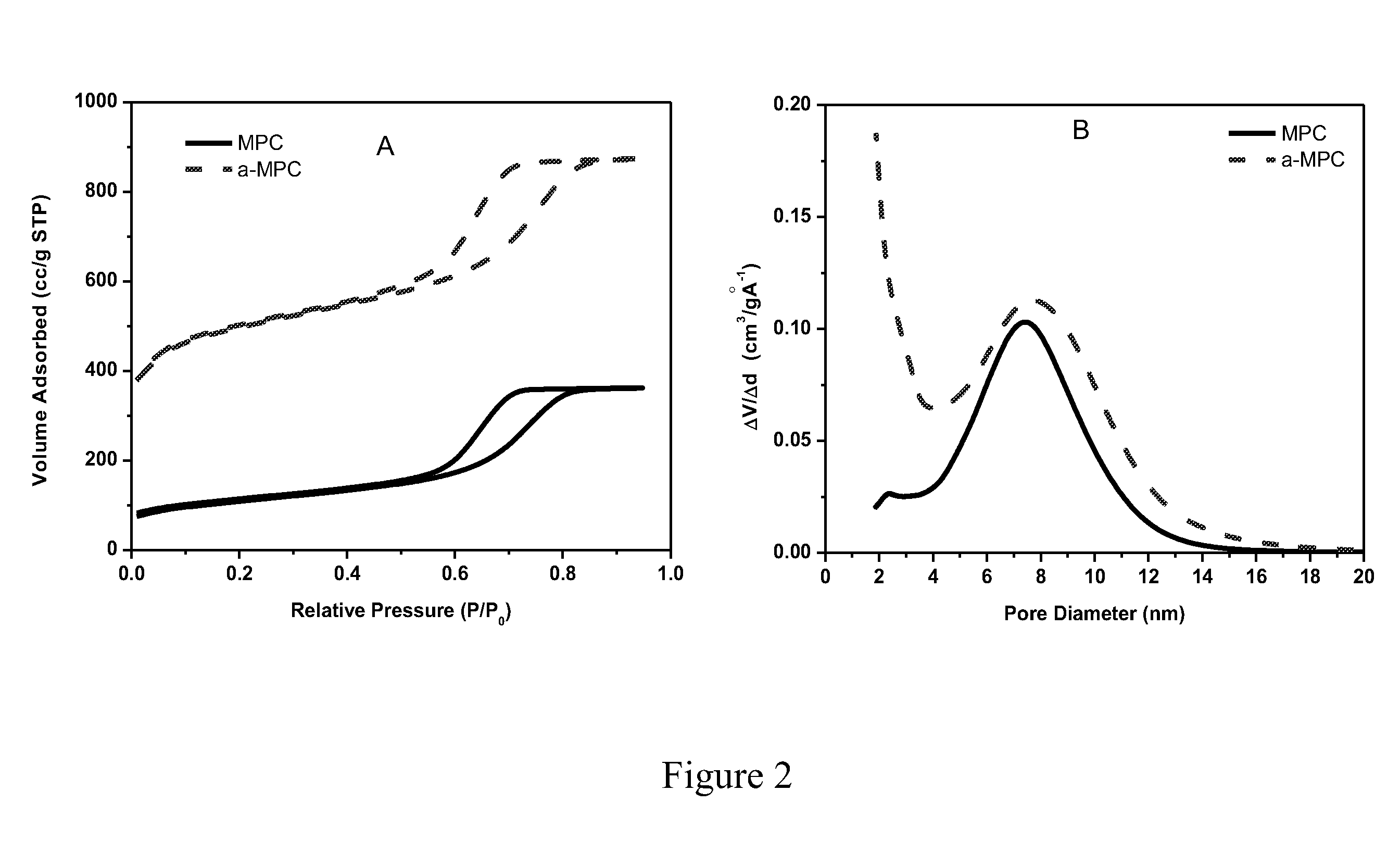Sulfur-carbon nanocomposites and their application as cathode materials in lithium-sulfur batteries
a lithium-sulfur battery and carbon nanocomposite technology, applied in the direction of non-aqueous electrolyte cells, cell components, electrochemical generators, etc., can solve the problems of poor electrochemical contact of sulfur, low utilization of active materials in the cathode, and the low implementation of the lithium-sulfur system in high-power applications. to achieve the effect of minimizing the formation of lithium sulfid
- Summary
- Abstract
- Description
- Claims
- Application Information
AI Technical Summary
Benefits of technology
Problems solved by technology
Method used
Image
Examples
example 1
Preparation of the Bimodal Porous Carbon Material (a-MPC) and Treatment Thereof to Form the Sulfur-Carbon Composite
[0064]The general procedure for preparing the sulfur-carbon composite is shown in FIG. 1. FIG. 1 also depicts the change in arrangement of sulfur in the bimodal carbon material during charging and discharging steps.
[0065]Preparation of bimodal porous carbon material (a-MPC). The Precursor mesoporous carbon (MPC) was synthesized through a previously reported soft-template approach (Wang, X. Q.; Liang, C. D.; Dai, S. Langmuir 2008, 24, 7500-7505; Liang, C. D.; Dai, S. Journal of the American Chemical Society 2006, 128, 5316-5317; and Liang, C. D.; Hong, K. L.; Guiochon, G. A.; Mays, J. W.; Dai, S. Angewandte Chemie-International Edition 2004, 43, 5785-5789). The MPC has a uniform mesopore distribution at ca. 7.3 nm, an average wall thickness of about 6 nm, a specific Brunauer-Emmett-Teller (BET) surface area of 368.5 m2 / g, and a pore volume of 0.56 cm3 / g.
[0066]The MPC was...
example 2
Analysis of the Sulfur-Carbon Composite
[0068]The surface area (SA) and pore size distribution (PSD) of the S / C composites produced as described in Example 1 were analyzed through N2 adsorption / desorption measurements at 77 K and plotted in FIGS. 4 (A and B). The N2 isotherms of these samples have a capillary condensation step centered at relative pressure (P / P0) of 0.7 and a H1 type hysteresis. The samples S_C01 to S_C05 have a bimodal pore size distribution with mesopores averaged at 7.3 nm. The cumulative pore volume (FIG. 4C) of samples with sulfur loading less than 37.1 wt. % shows an upward inflection point at pore diameter of 3 nm. Therefore, a portion of the pore volume and surface area of samples with sulfur loading less than 37.1 wt. % are attributed to small mesopores (pore size <3 nm) and micropores. FIG. 4D illustrates the dependence of pore volume and surface area on sulfur loading. The micropore volume was completely filled up when the sulfur loading is above 37.1 wt. ...
example 3
Assembly of Lithium-Sulfur Batteries
[0069]The S / C composites, prepared as described above, were pulverized by a ball mill and sieved through a 25 μm-opening stainless steel sieve. Slurries were prepared by mixing the S / C composites in a solution of 1 wt. % poly(vinylidene fluoride) (PVDF) in anhydrous N-methyl-2-pyrolidinone (NMP) in a 1:5 ratio. The slurries were applied to 10 mm diameter aluminum current collectors and dried at 120° C. for 4 hours. For the purpose of comparison, the original mesoporous carbon (MPC) with 24.1 wt. % sulfur loading and WVA-1500 (MeadWestvaco Corporation) with sulfur loading of 25.2 wt. % were also prepared as cathodes according to the same procedure used for the preparation of S / C composite cathodes. The batteries were assembled as Swagelok cells by using the S / C composite coated aluminum foil (10 mm diameter, 7 mm thick) as the cathode, and a lithium foil (7 mm thick and 10 mm diameter) as the anode, a Celgard 3225 separator (10.3 mm diameter), and ...
PUM
| Property | Measurement | Unit |
|---|---|---|
| conductivity | aaaaa | aaaaa |
| pore size | aaaaa | aaaaa |
| pore size | aaaaa | aaaaa |
Abstract
Description
Claims
Application Information
 Login to View More
Login to View More - R&D
- Intellectual Property
- Life Sciences
- Materials
- Tech Scout
- Unparalleled Data Quality
- Higher Quality Content
- 60% Fewer Hallucinations
Browse by: Latest US Patents, China's latest patents, Technical Efficacy Thesaurus, Application Domain, Technology Topic, Popular Technical Reports.
© 2025 PatSnap. All rights reserved.Legal|Privacy policy|Modern Slavery Act Transparency Statement|Sitemap|About US| Contact US: help@patsnap.com



